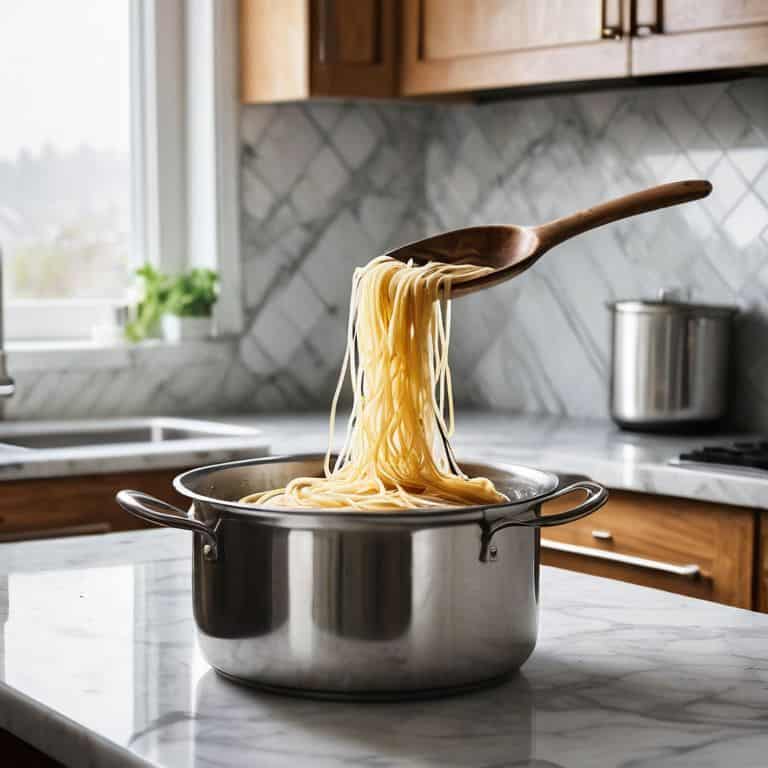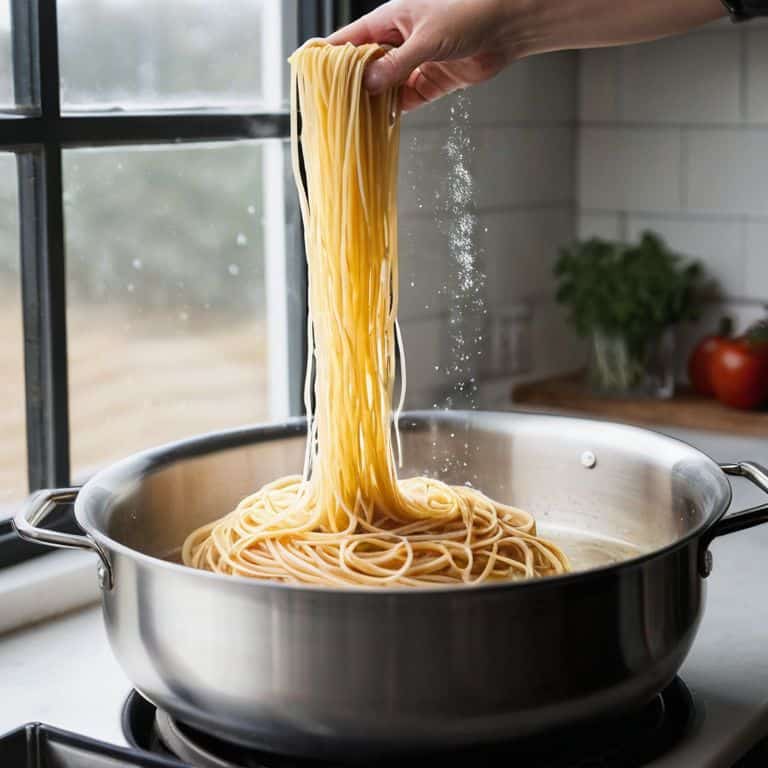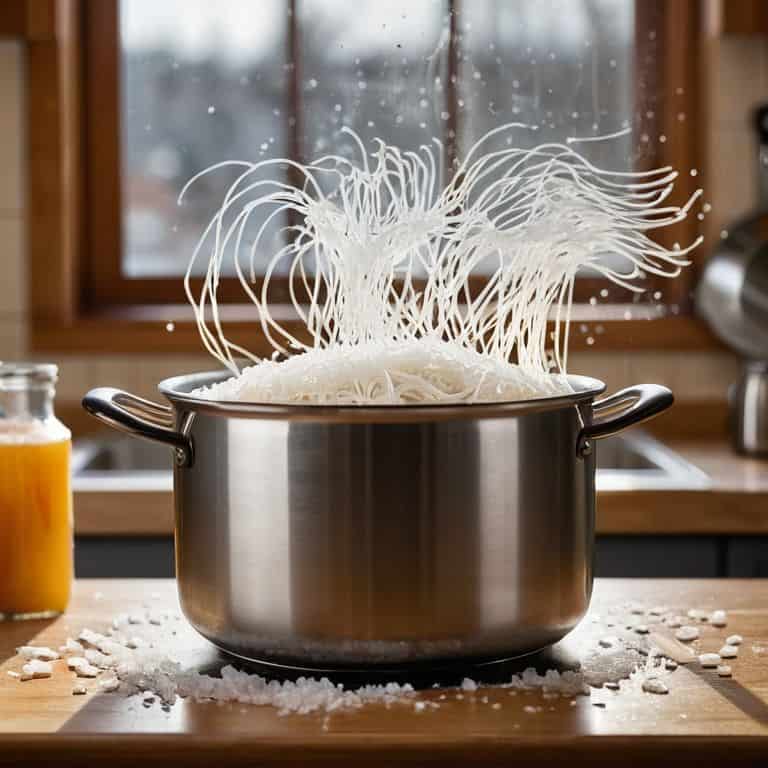I still remember the first time I had a perfectly cooked pasta dish, and it was all because my instructor at flight school emphasized the importance of salting your pasta water. It wasn’t just about throwing some salt in the pot; it was about understanding the chemistry behind it, much like navigating through turbulence. As a former bush pilot, I’ve learned to appreciate the little things, like a well-salted pasta dish, and I’m here to tell you that it’s not just about the taste – it’s about the principle.
In this article, I’ll share with you my no-nonsense approach to cooking pasta, just like I would teach a student pilot about the fundamentals of flying. I’ll break down the myths and provide you with simple, actionable steps to achieve the perfect pasta dish. My goal is to make you feel confident in the kitchen, just like I do when I’m in the cockpit. So, buckle up and let’s dive into the world of pasta cooking, where precision and patience are key to a successful flight – or in this case, a delicious meal.
Table of Contents
- Navigating Pasta Water Chemistry
- The Importance of Salting Your Pasta Water
- Cleared for Takeoff: 5 Essential Tips for Salting Your Pasta Water
- Key Takeaways: Flying High with Perfectly Seasoned Pasta
- Flying High on Flavor
- Landing Safely: The Importance of Salting Your Pasta Water
- Frequently Asked Questions
Navigating Pasta Water Chemistry

When it comes to cooking pasta, understanding pasta water chemistry is crucial. You see, adding salt to the water isn’t just about flavor; it’s about creating an environment that helps the pasta cook evenly. The optimal salt to water ratio is key, as it affects the texture of the pasta. Too little salt, and the pasta may become mushy; too much, and it’s overcooked.
As a flight instructor, I like to think of salting pasta water as plotting a safe flight plan. You need to consider the variables, like the type of pasta and the desired texture, to determine the right amount of salt. The effect of salt on pasta texture is significant, as it helps to break down the starches and create a more even cook. Common mistakes in salting pasta water include adding salt too late or using too little, which can result in underseasoned pasta.
By understanding the role of salt in pasta cooking time, you can optimize your cooking process. Salt enhancement of flavors is a real thing, and it’s not just about adding flavor to the pasta. The right amount of salt can bring out the natural flavors of the dish, creating a more balanced taste experience. As I always say, “a good recipe is like a good flight plan – it’s all about the details.”
Optimal Salt to Water Ratio the Flight Plan
When it comes to salting your pasta water, having the right ratio is crucial. I like to think of it as plotting a course for flavor. You want to ensure that your dish takes off in the right direction, and that’s where the optimal salt to water ratio comes in. This balance is what sets the stage for a truly enjoyable meal.
As a flight instructor, I always emphasize the importance of following a checklist. In this case, the ratio of salt to water is your pre-flight checklist. Aim for about one tablespoon of salt for every four cups of water, and you’ll be flying high in no time. This simple step can make all the difference in bringing out the natural flavors of your pasta, and it’s a technique that I highly recommend.
Salt Enhancement of Flavors the Co Pilot
As we delve into the world of pasta water, it’s essential to understand the role of salt as a flavor enhancer. Just like how a co-pilot assists the pilot in navigating through turbulence, salt helps to bring out the natural flavors of the pasta and any accompanying sauces. This synergy is crucial in creating a well-balanced dish.
When salt is added to pasta water, it helps to amplify the flavors of the ingredients, much like how a flight plan is executed to reach the desired destination. By doing so, the overall taste experience is elevated, and the dish becomes more enjoyable to consume.
The Importance of Salting Your Pasta Water

As I always tell my students, mastering the basics is key to a successful flight, or in this case, a perfectly cooked pasta dish. When it comes to salting your pasta water, it’s not just about adding a pinch of salt, it’s about understanding the pasta water chemistry and how it affects the overall flavor and texture. By adding salt to the water, you’re not only enhancing the flavors of the pasta, but also helping to break down the starches, resulting in a smoother texture.
One of the most common mistakes people make when salting their pasta water is not using the optimal salt to water ratio. This can lead to an over-salted or under-salted dish, which can be just as disastrous as navigating through a storm without a clear flight plan. By finding the right balance, you can bring out the natural flavors of the pasta and create a dish that’s truly elevated. Whether you’re a seasoned pilot or a novice cook, getting this ratio right is crucial to achieving a delicious and satisfying meal.
In the world of aviation, we always say that attention to detail is key to a safe and successful flight. The same applies to cooking, especially when it comes to salting your pasta water. By paying close attention to the effect of salt on pasta texture, you can create a dish that’s not only flavorful but also textured to perfection. So, the next time you’re cooking up a storm in the kitchen, remember to take a cue from the world of aviation and focus on the little details that make all the difference.
Avoiding Turbulence Common Mistakes to Watch
When cooking pasta, it’s easy to get caught up in the excitement of takeoff and forget to salt the water. However, this oversight can lead to a lackluster flavor that’s hard to recover from. As a flight instructor, I always stress the importance of following a pre-flight checklist, and salting your pasta water should be at the top of your culinary checklist.
To ensure a smooth flight, avoid over-salting, as this can lead to a dish that’s as unpleasant as turbulent air. Instead, aim for a balanced flavor that will leave your taste buds feeling like they’ve landed safely on a sunny runway.
Smooth Landing Salts Effect on Texture and Time
When it comes to cooking pasta, texture is just as important as flavor. Salting your pasta water can help you achieve that perfect al dente texture, making each bite a joy to eat. By adding salt to the water, you’re creating an environment that helps the pasta cook more evenly, resulting in a better texture.
As you’re waiting for your pasta to cook, keep in mind that salt also affects the cooking time. The salt helps to break down the starches on the surface of the pasta, allowing it to cook more quickly and preventing it from becoming mushy. This is especially important when cooking delicate types of pasta, as it can make all the difference in achieving a smooth landing – or in this case, a perfectly cooked dish.
Cleared for Takeoff: 5 Essential Tips for Salting Your Pasta Water
- Pre-flight check: Always use kosher or sea salt for the best flavor enhancement, just like how the right fuel mix is crucial for a smooth flight
- Plot your course: Aim for a salt-to-water ratio of 1:4 to 1:6, depending on personal taste, to avoid over-salting and ensure a safe culinary landing
- Navigate the chemistry: Understand how salt enhances flavors by suppressing bitter tastes and amplifying sweet and umami flavors, just like how a co-pilot helps navigate through turbulent skies
- Avoid turbulence: Don’t add salt too late in the cooking process, as this can lead to uneven flavor distribution, and always salt the water before adding pasta to ensure a smooth ride
- Smooth landing: Monitor your pasta’s texture and adjust cooking time accordingly, as salt can help pasta cook more evenly and retain its texture, making for a perfect culinary touchdown
Key Takeaways: Flying High with Perfectly Seasoned Pasta
Salting your pasta water is not just a recommendation, it’s a crucial step in enhancing flavors and ensuring a smooth culinary flight
Understanding the optimal salt to water ratio is vital, just like plotting a safe flight plan, to achieve the perfect balance of taste and texture
By avoiding common mistakes and leveraging the benefits of salt on pasta texture and cooking time, you’ll be landing your dishes safely and deliciously, every time
Flying High on Flavor
Just as a well-planned flight route can make all the difference in a safe and enjoyable journey, salting your pasta water is the navigational chart to unlocking a world of flavor and texture in your cooking, and trust me, it’s a lesson worth learning for a smooth culinary ride.
Daniel Sato
Landing Safely: The Importance of Salting Your Pasta Water

As we touch down on our discussion about salting pasta water, let’s do a quick preflight review of the key points we’ve covered. We’ve navigated the chemistry of pasta water, understanding how salt acts as a _co-pilot_ to enhance flavors. We’ve also plotted our optimal flight plan by determining the best salt to water ratio. Additionally, we’ve discussed common mistakes to avoid, like not salting the water at all, and how salt affects the texture and cooking time of our pasta. By following these simple steps, you’ll be well on your way to creating delicious, restaurant-quality dishes.
So, the next time you’re cooking up a storm in the kitchen, remember that salting your pasta water is not just a _good idea_, it’s a fundamental principle of good cooking. Just as a safe flight requires a careful pre-flight checklist, a great pasta dish requires a thoughtful approach to its preparation. By embracing this simple yet powerful technique, you’ll be taking your cooking to new heights, and who knows, you might just find that the joy of cooking is a lot like the thrill of flying – exhilarating, freeing, and full of endless possibilities.
Frequently Asked Questions
What happens if I add too much salt to my pasta water?
Adding too much salt can be like flying into a storm – it’ll throw off the whole dish. Excessive salt can make your pasta inedible, so it’s crucial to stick to the optimal ratio. If you do over-salt, don’t panic, just be prepared to adjust with additional ingredients or a clever sauce to balance it out.
Can I use any type of salt for pasta water or are there specific recommendations?
When it comes to salting your pasta water, not all salts are created equal. I recommend using a coarse, flaky sea salt or kosher salt – they dissolve well and provide a clean flavor profile. Avoid using table salt or finely ground salts, as they can leave a bitter taste. Think of it like choosing the right fuel for your aircraft – the right salt ensures a smooth flight for your pasta.
How does salting pasta water affect the cooking time and texture of different types of pasta?
Salting pasta water is like adjusting your flight plan for optimal altitude – it affects cooking time and texture. Generally, salted water cooks pasta 1-2 minutes faster and results in a firmer texture, especially for denser shapes like pappardelle or rigatoni.
